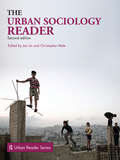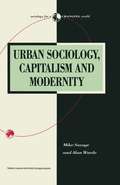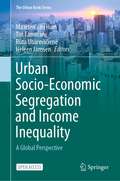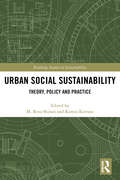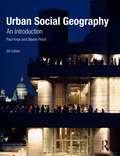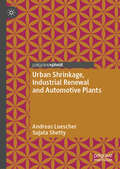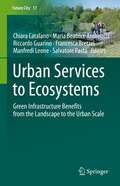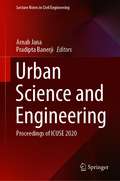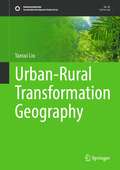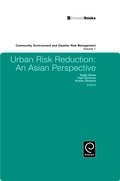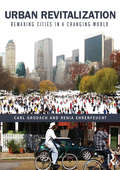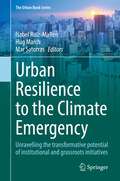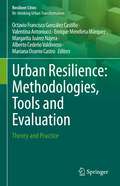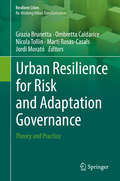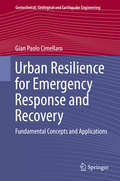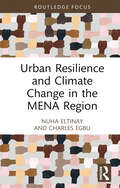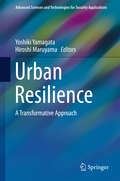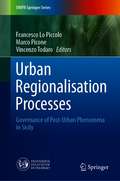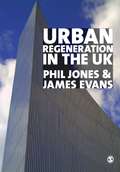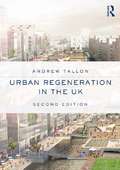- Table View
- List View
The Urban Sociology Reader (Routledge Urban Reader Series)
by Jan Lin Christopher MeleThe urban world is an exciting terrain for investigating the central institutions, structures and problems of the social world and how they have transformed through the last 200 years. This Reader comprises sections on urban social theory, racial and social difference in the city, culture in everyday life, culture and the urban economy, globalization and transnational social relations and the regulation of urban space. Drawing together seminal selections covering the nineteenth to the twenty-first centuries, this Reader includes forty-three significant writings from eminent names such as Simmel, Wirth, Park, Burgess, DuBois, Zukin, Sassen, and Harvey. The 2nd edition illuminates more recent urban issues such as sprawl, sustainability, immigration and urban protest. Selections are predominantly sociological, but some readings cross disciplinary boundaries. Providing an essential resource for students of urban studies, this book brings together important but, till now, widely dispersed writings. Editorial commentaries precede each entry; introducing the text, demonstrating its significance, and outlining the issues surrounding its topic, whilst the associated bibliography enables deeper investigations.
Urban Sociology, Capitalism and Modernity (Sociology for a Changing World)
by Michael Savage Alan WardeThis text seeks to defend the achievements of urban sociology and its contribution to evaluating theories of the nature and implications of both capitalism and modernity. The book reviews the history of urban sociology, theories of uneven development, studies of urban inequalities, analyses of urban culture and meaning and urban politics. It argues that urban sociology can be conceived as an extended empirical inquiry into the nature of capitalist modernity.
Urban Socio-Economic Segregation and Income Inequality: A Global Perspective (The Urban Book Series)
by Maarten Van Ham Tiit Tammaru Rūta Ubarevičienė Heleen JanssenThis open access book investigates the link between income inequality and socio-economic residential segregation in 24 large urban regions in Africa, Asia, Australia, Europe, North America, and South America. It offers a unique global overview of segregation trends based on case studies by local author teams. The book shows important global trends in segregation, and proposes a Global Segregation Thesis.Rising inequalities lead to rising levels of socio-economic segregation almost everywhere in the world. Levels of inequality and segregation are higher in cities in lower income countries, but the growth in inequality and segregation is faster in cities in high-income countries. This is causing convergence of segregation trends. Professionalisation of the workforce is leading to changing residential patterns. High-income workers are moving to city centres or to attractive coastal areas and gated communities, while poverty is increasingly suburbanising. As a result, the urban geography of inequality changes faster and is more pronounced than changes in segregation levels. Rising levels of inequality and segregation pose huge challenges for the future social sustainability of cities, as cities are no longer places of opportunities for all.
Urban Social Sustainability: Theory, Policy and Practice (Routledge Studies in Sustainability)
by Ramin Keivani M. Reza ShiraziThis ground breaking volume raises radical critiques and proposes innovative solutions for social sustainability in the built environment. Urban Social Sustainability provides an in-depth insight into the discourse and argues that every urban intervention has a social sustainability dimension that needs to be taken into consideration, and incorporated into a comprehensive and cohesive ‘urban agenda’ that is built on three principles of recognition, integration, and monitoring. This should be achieved through a dialogical and reflexive process of decision-making. To achieve sustainable communities, social sustainability should form the basis of a constructive dialogue and be interlinked with other areas of sustainable development. This book underlines the urgency of approaching social sustainability as an urban agenda and goes on to make suggestions about its formulation. Urban Social Sustainability consists of original contributions from academics and experts within the field and explores the significance of social sustainability from different perspectives. Areas covered include urban policy, transportation and mobility, urban space and architectural form, housing, urban heritage, neighbourhood development, and urban governance. Drawing on case studies from a number of countries and world regions the book presents a multifaceted and interdisciplinary understanding from social sustainability in urban settings, and provides practitioners and policy makers with innovative recommendations to achieve more socially sustainable urban environment.
Urban Social Sustainability: Theory, Policy and Practice (Routledge Studies in Sustainability)
by M. Reza Shirazi Ramin KeivaniThis ground breaking volume raises radical critiques and proposes innovative solutions for social sustainability in the built environment. Urban Social Sustainability provides an in-depth insight into the discourse and argues that every urban intervention has a social sustainability dimension that needs to be taken into consideration, and incorporated into a comprehensive and cohesive ‘urban agenda’ that is built on three principles of recognition, integration, and monitoring. This should be achieved through a dialogical and reflexive process of decision-making. To achieve sustainable communities, social sustainability should form the basis of a constructive dialogue and be interlinked with other areas of sustainable development. This book underlines the urgency of approaching social sustainability as an urban agenda and goes on to make suggestions about its formulation. Urban Social Sustainability consists of original contributions from academics and experts within the field and explores the significance of social sustainability from different perspectives. Areas covered include urban policy, transportation and mobility, urban space and architectural form, housing, urban heritage, neighbourhood development, and urban governance. Drawing on case studies from a number of countries and world regions the book presents a multifaceted and interdisciplinary understanding from social sustainability in urban settings, and provides practitioners and policy makers with innovative recommendations to achieve more socially sustainable urban environment.
Urban Social Geography: An Introduction
by Paul Knox Steven PinchThe 6th edition of this highly respected text builds upon the successful structure, engaging writing style and clear presentation of previous editions. Examining urban social geography from a theoretical and historical perspective, it also explores how it has developed into the modern day. Taking account of recent critical work, whilst simultaneously presenting well established approaches to the subject, it ensures students are well-informed about all the issues. The result is a topical book that is clear and accessible for students
Urban Social Geography: An Introduction
by Paul Knox Steven PinchThe 6th edition of this highly respected text builds upon the successful structure, engaging writing style and clear presentation of previous editions. Examining urban social geography from a theoretical and historical perspective, it also explores how it has developed into the modern day. Taking account of recent critical work, whilst simultaneously presenting well established approaches to the subject, it ensures students are well-informed about all the issues. The result is a topical book that is clear and accessible for students
Urban Shrinkage, Industrial Renewal and Automotive Plants
by Andreas Luescher Sujata ShettyThis book focuses on the relationship between the auto industry and the built environment at multiple scales, a topic of particular interest now as the industry is going through a period of major transformation. Drawing from multiple perspectives, including architecture, urban design and urban planning, the authors examine the changing form of the auto factory itself, the changing geography of auto production, and the challenges faced by communities as the auto plants that once brought them prosperity, and often a sense of identity, leave town. They examine four places that are dealing in different ways, and with varying success, with the aftermath of a decommissioned auto plant in their midst. These are Janesville, Wisconsin, and Willow Run, Michigan, in the U.S., and Bochum, Germany, and Genk, Belgium, in Europe. Together these four cases provide some clues about what the future might look like for places that were once intimately connected with the manufacture of cars.
Urban Services to Ecosystems: Green Infrastructure Benefits from the Landscape to the Urban Scale (Future City #17)
by Chiara Catalano Maria Beatrice Andreucci Riccardo Guarino Francesca Bretzel Manfredi Leone Salvatore PastaThe aim of this book is to bring together multidisciplinary research in the field of green infrastructure design, construction and ecology. The main core of the volume is constituted by contributions dealing with green infrastructure, vegetation science, nature-based solutions and sustainable urban development. The green infrastructure and its ecosystem services, indeed, are gaining space in both political agendas and academic research. However, the attention is focused on the services that nature is giving for free to and for human health and survival. What if we start to see things from another perspective? Our actions shall converge for instance to turn man-made environment like cities from heterotrophic to autotrophic ecosystems. From landscape ecology to urban and building design, like bricks of a wall, from the small scale to the bigger landscape scale via ecological networks and corridors, we should start answering these questions: what are the services that are we offering to Nature? What are we improving? How to implement our actions? This book contains three Open Access chapters, which are licensed under the terms of the Creative Commons Attribution 4.0 International License (CC BY 4.0).
Urban Science and Engineering: Proceedings of ICUSE 2020 (Lecture Notes in Civil Engineering #121)
by Arnab Jana Pradipta BanerjiThis book comprises select proceedings of the First International Conference on Urban Science and Engineering. The focus of the conference was on the milieu of urban planning while applying technology which ensures better urban life, coupled with sensitivity to depleting natural resources and focus on sustainable development. The contents focus on sustainable infrastructure, mobility and planning, urban water and sanitization, green construction materials, optimization and innovation in structural design, and more. This book aims to provide up-to-date and authoritative knowledge from both industrial and academic worlds, sharing best practice in the field of urban science and engineering. This book is beneficial to students, researchers, and professionals working in the field of smart materials and sustainable development.^
Urban-Rural Transformation Geography (Sustainable Development Goals Series)
by Yansui LiuThis book attempts to introduce the theory of system science and engineering technology into the geographic research of urban-rural transformation, reveals the level-structure-function of urban-rural transformation, and promotes the scientific research on urban-rural transformation. Focusing on the systematic diagnosis of new-type urbanization, urban-rural land use, industrial structure transformation and public facilities allocation, this book explores the long-term mechanism, innovative model, and scientific way of urban-rural land optimal allocation and spatial reconstruction and develops urban-rural transformation geography. In terms of the contents, the book constructs the theory and method system of urban-rural transformation geography, analyzes the process, pattern, mechanism, and response of urban-rural transformation, reveals the evolution characteristics, types, and regional differences of urban-rural regional system, and finally puts forward the optimal decision-making of urban-rural transformation.This book not only provides references for graduate and researchers in geography, regional development, urban and rural planning, resource science, environmental science, human-earth system science, sustainability science, and other related fields but also guides the decision-making of planners and government officials.
Urban Risk Reduction: An Asian Perspective (Community, Environment and Disaster Risk Management #1)
by Rajib Shaw Hari Srinivas Anshu SharmaAs cities all over the world have urbanized rapidly after the industrial revolution, most cities have confronted environmental problems such as poor air and water quality, high levels of traffic congestion and ambient noise, poor-quality built environment, derelict land, greenhouse gas emissions, urban sprawl, generation of waste and waste-water. In particular, cities in the developing world face problems related to the living conditions in which the urban population lives. In the context of urban cities in the developing world, it can be narrowed to the quality of life of living population in the cities. Needless to say that Asia has the largest population, as well as urban population at risk. This book brings the lessons from innovative urban risk management approaches in Asian cities, drawing the lessons from seven Asian countries. The authors of the chapters consists of wider spectrum of stakeholders: from academicians to policy makers to NGO practitioners.
Urban Revitalization: Remaking cities in a changing world
by Carl Grodach Renia EhrenfeuchtFollowing decades of neglect and decline, many US cities have undergone a dramatic renaissance. From New York to Nashville and Pittsburgh to Portland governments have implemented innovative redevelopment strategies to adapt to a globally integrated, post-industrial economy and cope with declining industries, tax bases, and populations. However, despite the prominence of new amenities in revitalized neighborhoods, spectacular architectural icons, and pedestrian friendly entertainment districts, the urban comeback has been highly uneven. Even thriving cities are defined by a bifurcated population of creative class professionals and a low-wage, low-skilled workforce. Many are home to diverse and thriving immigrant communities, but also contain economically and socially segregated neighborhoods. They have transformed high-profile central city brownfields, but many disadvantaged neighborhoods continue to grapple with abandoned and environmentally contaminated sites. As urban cores boom, inner-ring suburban areas increasingly face mounting problems, while other shrinking cities continue to wrestle with long-term decline. The Great Recession brought additional challenges to planning and development professionals and community organizations alike as they work to maintain successes and respond to new problems. It is crucial that students of urban revitalization recognize these challenges, their impacts on different populations, and the implications for crafting effective and equitable revitalization policy. Urban Revitalization: Remaking Cities in a Changing World will be a guide in this learning process. This textbook will be the first to comprehensively and critically synthesize the successful approaches and pressing challenges involved in urban revitalization. The book is divided into five sections. In the introductory section, we set the stage by providing a conceptual framework to understand urban revitalization that links a political economy perspective with an appreciation of socio-cultural factors in explaining urban change. Stemming from this, we will explain the significance of revitalization and present a summary of the key debates, issues and conflicts surrounding revitalization efforts. Section II will examine the historical causes for decline in central city and inner-ring suburban areas and shrinking cities and, building from the conceptual framework, discuss theory useful to explain the factors that shape contemporary revitalization initiatives and outcomes. Section III will introduce students to the analytical techniques and key data sources for urban revitalization planning. Section IV will provide an in-depth, criticaldiscussion of contemporary urban revitalization policies, strategies, and projects. This section will offer a rich set of case studies that contextualize key themes and strategic areas across a range of contexts including the urban core, central city neighborhoods, suburban areas, and shrinking cities. Lastly, Section V concludes by reflecting on the current state of urban revitalization planning and the emerging challenges the field must face in the future.Urban Revitalization will integrate academic and policy research with professional knowledge and techniques. Its key strength will be the combination of a critical examination of best practices and innovative approaches with an overview of the methods used to understand local situations and urban revitalization processes. A unique feature will be chapter-specific case studies of contemporary urban revitalization projects and questions geared toward generatingclassroom discussion around key issues. The book will be written in an accessible style and thoughtfully organized to provide graduate and upper-level undergraduate students with a comprehensive resource that will also serve as a reference guide for professionals
Urban Revitalization: Remaking cities in a changing world
by Carl Grodach Renia EhrenfeuchtFollowing decades of neglect and decline, many US cities have undergone a dramatic renaissance. From New York to Nashville and Pittsburgh to Portland governments have implemented innovative redevelopment strategies to adapt to a globally integrated, post-industrial economy and cope with declining industries, tax bases, and populations. However, despite the prominence of new amenities in revitalized neighborhoods, spectacular architectural icons, and pedestrian friendly entertainment districts, the urban comeback has been highly uneven. Even thriving cities are defined by a bifurcated population of creative class professionals and a low-wage, low-skilled workforce. Many are home to diverse and thriving immigrant communities, but also contain economically and socially segregated neighborhoods. They have transformed high-profile central city brownfields, but many disadvantaged neighborhoods continue to grapple with abandoned and environmentally contaminated sites. As urban cores boom, inner-ring suburban areas increasingly face mounting problems, while other shrinking cities continue to wrestle with long-term decline. The Great Recession brought additional challenges to planning and development professionals and community organizations alike as they work to maintain successes and respond to new problems. It is crucial that students of urban revitalization recognize these challenges, their impacts on different populations, and the implications for crafting effective and equitable revitalization policy. Urban Revitalization: Remaking Cities in a Changing World will be a guide in this learning process. This textbook will be the first to comprehensively and critically synthesize the successful approaches and pressing challenges involved in urban revitalization. The book is divided into five sections. In the introductory section, we set the stage by providing a conceptual framework to understand urban revitalization that links a political economy perspective with an appreciation of socio-cultural factors in explaining urban change. Stemming from this, we will explain the significance of revitalization and present a summary of the key debates, issues and conflicts surrounding revitalization efforts. Section II will examine the historical causes for decline in central city and inner-ring suburban areas and shrinking cities and, building from the conceptual framework, discuss theory useful to explain the factors that shape contemporary revitalization initiatives and outcomes. Section III will introduce students to the analytical techniques and key data sources for urban revitalization planning. Section IV will provide an in-depth, criticaldiscussion of contemporary urban revitalization policies, strategies, and projects. This section will offer a rich set of case studies that contextualize key themes and strategic areas across a range of contexts including the urban core, central city neighborhoods, suburban areas, and shrinking cities. Lastly, Section V concludes by reflecting on the current state of urban revitalization planning and the emerging challenges the field must face in the future.Urban Revitalization will integrate academic and policy research with professional knowledge and techniques. Its key strength will be the combination of a critical examination of best practices and innovative approaches with an overview of the methods used to understand local situations and urban revitalization processes. A unique feature will be chapter-specific case studies of contemporary urban revitalization projects and questions geared toward generatingclassroom discussion around key issues. The book will be written in an accessible style and thoughtfully organized to provide graduate and upper-level undergraduate students with a comprehensive resource that will also serve as a reference guide for professionals
Urban Resilience to the Climate Emergency: Unravelling the transformative potential of institutional and grassroots initiatives (The Urban Book Series)
by Isabel Ruiz-Mallén Hug March Mar SatorrasThis volume sheds light on urban resilience strategies in times of climate emergency and social and economic crisis by reflecting on related social vulnerabilities and inequalities within cities and showing the potential of participatory governance approaches for socio-environmental transformation. The book compiles critical research documenting the articulation of urban resilience strategies dealing with climatic changes, as well as the understanding of the unexpected implications of top-down resilience plans to address the impacts of climate change in cities, especially on the most vulnerable urban populations, and the transformative capacities of bottom-up and socially innovative resilience strategies. The book especially focuses on co-produced and grassroots transformative processes that are concerned with social equity in urban planning for climate change. Although several publications cover the topic of urban resilience, this book provides a more nuanced exploration of urban climate governance and citizen engagement in urban climate resilience policies through the lenses of political ecology, environmental justice and co-production. In this regard, the volume moves beyond the approach of multilevel urban climate governance by critically addressing the unexpected impacts of top-down strategies of urban resilience with the goal of expanding the reflection on citizen engagement. The book also explores the emerging possibilities behind the co-production of urban resilience as well as the critical role of grassroots and citizens in promoting such alternative strategies. While the primary target audience is scholars from different disciplines (e.g. geography, urban studies, planning, political ecology, architecture, urban sociology, environmental studies) focusing on urban resilience, the editors also aim to reach urban resilience practitioners from local, national and international organisations as well as environmental grassroots and climate activists.
Urban Resilience: Theory and Practice (Resilient Cities)
by Octavio Francisco González Castillo Valentina Antoniucci Enrique Mendieta Márquez Margarita Juárez Nájera Alberto Cedeño Valdiviezo Mariana Osorno CastroThis book presents a select set of papers from an international and multidisciplinary approach, outlining the vanguard in the field of methodology, tools, and evaluation of the movement towards urban resilience.Reflecting on and redesigning the guidelines that orient the planning and management of urban development has become, today, an issue of global scope and priority that demands the committed and determined participation of society. Faced with the formidable challenge of guiding our cities towards sustainability, it is necessary to develop new approaches, paradigms, models, methodologies, and tools that make it possible to assess and raise the resilience profile of urban socio-ecosystems. The experiences that are developed in this book offer a wide and diverse set of concepts, theories, methodologies, instruments, and casuistry, impregnated by resilience notion, to inspire, influence, and guide thinking and practice for architects, urban planners, government officials, businessmen, civil and research organizations. In this book, the reader will be able to review either theoretical-methodology to organize notions on urban resilience, or application cases in a variety of areas and subsystems of a city but, being all of them inevitably and intricately linked through a complex matrix of structures and interactions that determine future, well-being, and resilience of urban socio-ecosystems in the global anthropo-environment.
Urban Resilience for Risk and Adaptation Governance: Theory and Practice (Resilient Cities)
by Grazia Brunetta Ombretta Caldarice Nicola Tollin Marti Rosas-Casals Jordi MoratóThis book brings together a series of theory and practice essays on risk management and adaptation in urban contexts within a resilient and multidimensional perspective. The book proposes a transversal approach with regard to the role of spatial planning in promoting and fostering risk management as well as institutions’ challenges for governing risk, particularly in relation to new forms of multi-level governance that may include stakeholders and citizen engagement. The different contributions focus on approaches, policies, and practices able to contrast risks in urban systems generating social inclusion, equity and participation through bottom-up governance forms and co-evolution principles. Case studies focus on lessons learned, as well as the potential and means for their replication and upscaling, also through capacity building and knowledge transfer. Among many other topics, the book explores difficulties encountered in, and creative solutions found, community and local experiences and capacities, organizational processes and integrative institutional, technical approaches to risk issue in cities.
Urban Resilience for Emergency Response and Recovery: Fundamental Concepts and Applications (Geotechnical, Geological and Earthquake Engineering #41)
by Gian Paolo CimellaroThis book introduces the concepts of Resilience-Based Design (RBD) as an extension of Performance-Based Design. It provides readers with a range of cutting-edge methodologies for evaluating resilience and clarifies the difference between resilience, vulnerability and sustainability. Initially, the book focuses on describing the different types of uncertainty that arise in the context of resilience evaluation. This is followed by an entire chapter dedicated to the analytical and experimental recovery functions. Then, starting from the definition of resilience provided by MCEER, an extension of the methodology is provided that introduces the seven dimensions of Community Resilience, summarized in the acronym PEOPLES. They are: Population and Demographics, Environmental/Ecosystem, Organized Governmental Services, Physical infrastructures, Lifestyle and Community Competence, Economic Development, and Socio-Cultural Capital. For each dimension, components and subcomponents are defined and the related indices are provided.Underlining the importance of the physical infrastructure dimension, the book provides several examples of applications for transportation, hydraulic, gas and power networks. The problem of interdependencies and the domino effect is also taken into account during the analysis. One of the book’s closing chapters focuses on different methodologies for improving disaster preparedness and engineering mitigation strategies, while the last chapter describes the different computer platforms available on the market for evaluating Community Resilience.The book offers readers an extensive introduction to the concept of Resilience-Based Design, together with selected advanced applications for specialists. No prerequisite knowledge is needed in order to understand the book, and the Appendix offers valuable supplemental information on e.g. the probabilistic concepts. As such, the book offers a valuable resource for graduate students, young engineers and researchers who are interested in the topic, and can also be used as a supplementary text in graduate level Disaster Resilience courses.
Urban Resilience and Climate Change in the MENA Region (Routledge Focus on Environment and Sustainability)
by Nuha Eltinay Charles EgbuThis book provides an overview of the geopolitical context and climate change risk profile of the Middle East and North Africa (MENA) Region. Mapping existing scientific literature and key reports on MENA climate change impacts and future projections, Nuha Eltinay and Charles Egbu establish links between the Conference of the Parties (from COP26, COP27 to COP28) Glasgow–Sharm el-Sheikh Work Program for Progress on the Global Goal on Adaptation, and regional climate adaptation financing targets, national government investments, and human security in local case studies. They also address gaps in disaster risk reduction institutional governance for sustainable development in the region. The authors move beyond the existing theoretical understanding of urban resilience to investigate how it is being measured and assessed in MENA in alignment with the IPCC’s climate change adaptation indicators. Finally, they explore how disasters and conflict displacement vulnerabilities and fragility affecting the communities most in need are being measured and integrated into cities’ resilience action plans and national disaster risk policies. Providing guidance and policy recommendations based on empirical research and key stakeholder engagement observations, this book will be of great interest to students, scholars, and professionals who are researching and working in the areas of climate change, urban planning, and environmental policy and governance. As this book comes out just after the closure of The United Nations Climate Change Conference COP28 negotiations, it sets the scene for pre-COP regional context, and paves the way for researchers and practitioners to undertake post-COP28 key takeaways and multi-level government commitments into action, for better climate mitigation and adaptation investments, resilient and sustainable future for all.
Urban Resilience and Climate Change in the MENA Region (Routledge Focus on Environment and Sustainability)
by Nuha Eltinay Charles EgbuThis book provides an overview of the geopolitical context and climate change risk profile of the Middle East and North Africa (MENA) Region. Mapping existing scientific literature and key reports on MENA climate change impacts and future projections, Nuha Eltinay and Charles Egbu establish links between the Conference of the Parties (from COP26, COP27 to COP28) Glasgow–Sharm el-Sheikh Work Program for Progress on the Global Goal on Adaptation, and regional climate adaptation financing targets, national government investments, and human security in local case studies. They also address gaps in disaster risk reduction institutional governance for sustainable development in the region. The authors move beyond the existing theoretical understanding of urban resilience to investigate how it is being measured and assessed in MENA in alignment with the IPCC’s climate change adaptation indicators. Finally, they explore how disasters and conflict displacement vulnerabilities and fragility affecting the communities most in need are being measured and integrated into cities’ resilience action plans and national disaster risk policies. Providing guidance and policy recommendations based on empirical research and key stakeholder engagement observations, this book will be of great interest to students, scholars, and professionals who are researching and working in the areas of climate change, urban planning, and environmental policy and governance. As this book comes out just after the closure of The United Nations Climate Change Conference COP28 negotiations, it sets the scene for pre-COP regional context, and paves the way for researchers and practitioners to undertake post-COP28 key takeaways and multi-level government commitments into action, for better climate mitigation and adaptation investments, resilient and sustainable future for all.
Urban Resilience: A Transformative Approach (Advanced Sciences and Technologies for Security Applications #65)
by Yoshiki Yamagata Hiroshi MaruyamaThis book is on urban resilience – how to design and operate cities that can withstand major threats such as natural disasters and economic downturns and how to recover from them. It is a collection of latest research results from two separate but collaborating research groups, namely, researchers in urban design and those on general resilience theory. The book systematically deals with the core aspects of urban resilience: systems, management issues and populations.The taxonomy can be broken down into threats, systems, resilience cycles and recovery types in the context of urban resilience. It starts with a discussion of systems resilience models, focusing on the central idea that resilience is a moving average of costs (a set of trajectories in a two-player game paradigm). The second section explores management issues, including planning, operating and emergency response in cities with specific examples such as land-use planning and carbon-neutral scenarios for urban planning. The next section focuses on urban dwellers and specific people-related issues in the context of resilience. Agent-based simulation of behaviour and perception-based resilience, as well as brand crisis management are representative examples of the topics discussed. A further section examines systems like public utilities – including managing power supplies, cyber-security issues and models for pandemics. It concludes with a discussion of the future challenges and risks facing complex systems, for example in resilient power grids, making it essential reading for a wide range of researchers and policymakers.
Urban Regionalisation Processes: Governance of Post-Urban Phenomena in Sicily (UNIPA Springer Series)
by Francesco Lo Piccolo Marco Picone Vincenzo TodaroThis book explores the issues of transformation phenomena of the urban dimension (regionalization processes) that traditional scientific literature fails to describe appropriately. So far, scholars have adopted a widespread dominant perspective that proved unable to grasp the essence of post-modern complexities that urban spaces imply. The book provides a taxonomy, in order to describe the rules of these new and peculiar cities, by using the living dimension as a device for the epistemological breaking down of traditional socio-spatial analyses. After a thorough theoretical introduction, it describes two Sicilian case studies that prove particularly relevant to the construction of a new, alternative urban regionalization theory. These two areas, Palermo and South-Eastern Sicily, are described through several aspects, such as the role of migrants and migrations in defining urban regionalization, the power of fiction and the new urban forms that are slowly emerging in Sicily. Overall, this book provides a refreshing view of what Sicily has been and is becoming, by deconstructing most of its clichés and suggesting theoretical perspectives grounded in both quantitative and qualitative analyses.
Urban Regeneration in the UK: Theory and Practice (PDF)
by Dr James Evans Dr Phil JonesThe urban landscape of the UK is undergoing its most dramatic transformation since post-war reconstruction. This volume is a systematic guide to that transformation that draws together a mass of information - from policy reports to academic studies - into a single coherent text. Examining key aspects of the process from first principles, Urban Regeneration in the UK: - introduces and contextualises the UK urban regeneration agenda - brings together state-of-the-art research around key themes in governance, sustainability, competition, and design - uses case studies of UK contemporary regeneration projects - combines academic and theoretical explorations whilst linking theory and practice - includes pedagogical features of key learning points, useful websites, a glossary and further reading Aimed at those studying and working in the field of urban regeneration and planning, Urban Regeneration in the UK provides a highly readable introduction to urban regeneration for undergraduates, post-graduates, and practitioners.
Urban Regeneration in the UK
by Andrew TallonStriking transformations are taking place in the urban landscape. The regeneration of urban areas in the UK and around the world has become an increasingly important issue amongst governments and populations since the global economic downturn. This textbook provides an accessible and critical synthesis of urban regeneration in the UK, analyzing key policies, approaches, issues and debates. It places the historical and contemporary regeneration agenda in context. The second edition has been extensively revised and updated to incorporate advances in literature, policy and case study examples, as well as giving greater discussion to the New Labour period of urban policy, and the urban agenda and regeneration policies of the Conservative-Liberal Democrat Coalition government elected in 2010. The book is divided into five sections, with Section I establishing the conceptual and political framework for urban regeneration in the UK. Section II traces policies that have been adopted by central government to influence the social, economic and physical development of cities, including early town and country and housing initiatives, community-focused urban policies of the late 1960s, entrepreneurial property-led regeneration of the 1980s, competition for urban funds in the 1990s, urban renaissance and neighborhood renewal policies of the late 1990s and early 2000s, and new approaches since 2010 which have sought to stimulate enterprise and embrace localism in an age of austerity resulting from the global economic downturn. Section III illustrates the key thematic policies and strategies that have been pursued by cities themselves, focusing particularly on improving economic competitiveness, tackling social disadvantage and promoting sustainable urban regeneration. Section IV summarizes key issues and debates facing urban regeneration in the early 2010s, and speculates upon future directions in an era of economic and political uncertainty. Urban Regeneration in the UK combines the approaches taken by central government and cities themselves to regenerate urban areas, providing a comprehensive and up-to-date synthesis of the field. Each chapter also contains case studies, study questions, suggested further reading and websites, making this an essential resource for undergraduate students interested in Urban Studies, Geography, Planning and the Built Environment.
Urban Regeneration in the UK
by Andrew TallonStriking transformations are taking place in the urban landscape. The regeneration of urban areas in the UK and around the world has become an increasingly important issue amongst governments and populations since the global economic downturn. This textbook provides an accessible and critical synthesis of urban regeneration in the UK, analyzing key policies, approaches, issues and debates. It places the historical and contemporary regeneration agenda in context. The second edition has been extensively revised and updated to incorporate advances in literature, policy and case study examples, as well as giving greater discussion to the New Labour period of urban policy, and the urban agenda and regeneration policies of the Conservative-Liberal Democrat Coalition government elected in 2010. The book is divided into five sections, with Section I establishing the conceptual and political framework for urban regeneration in the UK. Section II traces policies that have been adopted by central government to influence the social, economic and physical development of cities, including early town and country and housing initiatives, community-focused urban policies of the late 1960s, entrepreneurial property-led regeneration of the 1980s, competition for urban funds in the 1990s, urban renaissance and neighborhood renewal policies of the late 1990s and early 2000s, and new approaches since 2010 which have sought to stimulate enterprise and embrace localism in an age of austerity resulting from the global economic downturn. Section III illustrates the key thematic policies and strategies that have been pursued by cities themselves, focusing particularly on improving economic competitiveness, tackling social disadvantage and promoting sustainable urban regeneration. Section IV summarizes key issues and debates facing urban regeneration in the early 2010s, and speculates upon future directions in an era of economic and political uncertainty. Urban Regeneration in the UK combines the approaches taken by central government and cities themselves to regenerate urban areas, providing a comprehensive and up-to-date synthesis of the field. Each chapter also contains case studies, study questions, suggested further reading and websites, making this an essential resource for undergraduate students interested in Urban Studies, Geography, Planning and the Built Environment.
